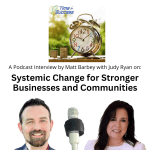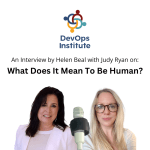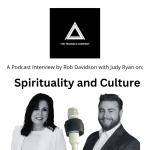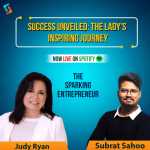
Chris MacLellan, CEO of Whole Care Network interviews Judy Ryan in podcast 04: Developing Culture as a Competitive Advantage
In this Culture Change In A Box episode, Judy Ryan from LifeWork Systems and Chris MacLellan from the Whole Care Network discuss the importance of positively implementing new systems in creating a Healthy Workplace Culture.
are you suffering from staff turnover too many lost business opportunities is your reputation at risk if so you know your workplace culture needs Improvement but determining how to do so and where to start is about as fun and effective as trying to assemble a puzzle with no picture to guide you culture change in a box is a show that takes you on a compelling Deep dive into an effective real-time culture change process so you can begin to feel hopeful and re-energized about your business and now here are your hosts for C change in a box Chris mclen and Judy Ryan well greetings everyone it’s Chris mclen from the hare network with Judy Ryan from Life work systems it’s great to see you Judy thank you it’s great to see you too it’s a little foggy outside today but uh we’re here bright and early yes and hopefully we’ll clear some fog around workplace culture very good I like that workplace culture turn over in an organization yes I would imagine that is probably one of the biggest concerns uh a management team would have if they’re they’re recognizing a number of people who are leaving right it’s definitely not a good sign when people are running out the door and I think it does literally keep some managers and owners awake at night um we we just recently um did some statistic analysis on just the cost of retention in various Industries for example we work in healthcare a lot and um to take a nurse an RNR and LPN and if they leave the cost to recruit them to orientate a new person hire them to train them and all the costs for uh traveling agencies or um temps or paying overtime to their uh current staff the total amount of money for that is around $80,000 soag 8,000 $8,000 and that’s um that’s kind of a a conservative estimate and same with uh organizations where they have a lot of assistance that can add up to millions of dollars if there’s a workplace culture problem and retention is an issue and so we see that as a as a big reason why people come to us and say we’ve got to do something to stop this we don’t even know what you what to do but you’ve got something we know want hear about it so you’re you’re almost anticipating my next question you know what do what is an organization or or or let’s say an owner is coming to you and they’re recognizing that they’re having a number of their good people leaving what’s the first what’s their first thought why why well one of the things that happens unfortunately is people don’t always know what they don’t know right so sometimes it’s almost accidental they they know they have this problem they’re noodling on it they’re probably researching or maybe looking for solutions they happen upon something that we’re doing whether it’s a keynote presentation or my book or an article and they recognized that there’s a solution that they hadn’t even considered so when when I wrote my book what’s the deal with workplace culture change the goal of that book was to help people to just look at the basic questions around what kind of culture would I want if I was going to make Improvement if I was going to try to attract and keep the best people and so what we we say very pointedly in that book is we have a bias for that we have a certain kind of model that we’re saying this is the one we would recommend to you because there’s lots of different models available to people and most of the time if we don’t have a conscious model we’re falling back on the default of what’s been always been done which is not necessarily working anymore because it’s always easier to go back to what you know right rather than trying something different exactly and what’s what was uh I think it was Einstein’s quote you you you Insanity to keep doing the same thing hoping for a new result so yeah so we are bringing a model we actually want an award at one point for innovation in our approach and it really is an innovation in the sense that it isn’t yet fully mainstream but it is the um it’s it’s move it’s a momentum growing around this type of model that I’m going to describe for you and um there’s a lot of thought leaders that are leading the way in the books that are being written in some of the case studies that are being built around developing culture as um as a competitive Advantage as a uh a way to bring the best version of your employees to the surface really like what you just said developing culture as a competitive Advantage yes that to me U that’s exciting to hear something like that it is but it’s not for the faint of heart oh no I can’t that’s that’s really that’s really culture change yes culture change requires a very courageous and determined leader at the top and then somebody that can influence their direct reports to actually putting a stake in the ground that’s unwavering and that’s really the biggest challenge and um the the most important job that I bring to the table is to help a leader understand this is the model and this is what it’s going to require of you and not have them go running from the room because it is actually um quite exhilarating to work with leaders who are courageous and who see that the old ways are not working and they’re willing to open to a different way um but it’s important that they are kind of handheld through that process because it’s not an easy one and it’s not a familiar one oh very much so cuz when you’re used to doing a system one way and all of a sudden you see that it’s not working it’s got to be it’s got to be a shock I think it is I think people think well if I just do the old system a little better and a little better that somehow it’s going to just all fall in place we’re going to work harder right and that’s all going to just change magically and it really is about completely changing a system so the people that we look to work with are people that are consciously aware that they have a problem and they’re not tolerant of keeping um keeping on the way that they have been so they’re ready for change they’re willing for change uh they are open to U being sort of vulnerable and that’s really an important thing that we look for I had a recent Prospect uh who was managing many many organization simultaneously and he said I need your help and I think I’m ready to get started and I said to him do you think you are or are you oh there’s a big difference between the two yeah and he kind of paused and looked at me and he goes I am ready and I said good and later we talked about that and I said do you realize that that is my most important thing to do is to recognize where your commitment level is so if it’s okay with you I’d like to tell you what I’m asking him to commit to oh that you see what’s so great with with these with these conversations because you anticipate my next question well I’m just thinking of this audience out there listening to us today and how they might be saying okay whatever what is it right so our model is called a responsibility based model and what that means is um most people they tend to think of culture as like what’s the leadership up to but in our model as you know um we’re all about developing the leadership and every person in the organization so critical so critical and and to most people the first thought they think is well that’s too expensive and too time consuming because in the old ways it probably was but with the new technology we have and the way that we can kind of globalize information out that is no longer an excuse for not making sure that everybody has the same access and information and practice and skill set and so when we talk about responsibility based what we mean by that is that the intent of the leaders is that everyone in the organization from every single position is responsible for their relationships and the quality of those relationships and they’re responsible for the level of productivity that they provide and they’re responsible for how engaged they are and how to work toward full engagement if they’re not fully engaged so that’s a completely different different it’s kind of like a like you said I think one time you know you could tell a kid oh you know I’m going to teach you how to clean or you could just say it’s easier if I do it myself right right one is teaching them to fish and the other is feeding them a fish and so we’re really all about teaching people how to fish in terms of their personal responsibility and so um the model is um not only responsibility based but it’s value based and at the core of it trustworthiness and all the behaviors associated with trustworthiness are important to make sure that those are occurring and that they’re being monitored and that there’s a sensitivity and an awareness about those um types of behaviors so I had a manager recently who’s in this model and he wrote an email to his staff saying hey we’re entering 2017 in the spirit of personal responsibility I noticed some of you aren’t doing your online training um I want and expect you to do it if you have dropped your commitment I want you to come talk to me about it if I see you’ve dropped your commitment and haven’t come to talk to me about it I will be coming to talk with you you’re not in trouble um I’m just not willing to do pseudo Community which in our terms is like Faking It pseudo Community pseudo community and I’m not going to and I’m not going to struggle and coers you but I will have conversations with you because um we’re a team that has committed to following through on commitments we’re a team that is has committed to trustworthiness so he he’s able to already reference phrases that we’re teaching around uh student Community around authentic Community around how to uh recognize when a trust value one of the trust values that he was recognizing is that I’m committed to being straightforward and he was saying that in his email because I’m working on being straightforward I’m going to put it out to you what I expect from you what I want from you and I’m going to ask you to communicate with me about it and that takes courage because most of the time the leaders are a little bit nervous about doing that because what if people get upset with me and they leave and my response always back to them is what if they stay and they don’t and they’re not interested in responsibility that’s a pretty big problem so it helps Center them a little bit and I guess it’s you coming from the manager’s perspective or or the or the owner’s perspective sometimes recognizing that change is difficult yes I think that they don’t even know what they’re signing up for when they get into it with us the good news is when we have really great leaders that we’ve kind of vetted for their willingness um no matter how rough it gets at first you know because it can be a little bit more than they anticipated um most of them are like you know I I get where we’re going and I see the value of it and yeah it can be a little hard but I’m I’m in I’m all in and that is uh the most exciting ride for me is to work with leaders of that kind of caliber that understand the longterm sustainability goals of creating an environment where we’re not going to have that turnover where people are going to want to stay creating a positive workplace culture yes yes and one of the things that we do that is different than most organizations is we really have a fully distributive model so we make sure that everybody gets access to the same information everybody has time to ponder and reflect on that information everybody has time to um practice how to use the tools and so it kind of levels the playing field around human systems there’s that there’s a wonderful term again system yes and and to just demystify that it just we have systems all the time we have computer systems we have systems in our cars that make our Windows go up and down and our radios work and all of that but we also have systems around people’s thought thinking processes the way that they feel right the way that they speak and act and we don’t necessarily monitor or manage those human systems um very intentionally so that’s what we do with bringing in hum because we we we really don’t often put that into that term we don’t think of there is a life work system there exactly and I think that’s why it doesn’t necessarily get the credibility that it needs for it to occur I always say it’s kind of like if you had a a light going off in your car that said you got an engine problem and you said well I just don’t yeah it’s not a big deal you know we wouldn’t do that right we would just recognize oh my gosh my car is a system that’s about ready to go fall apart and it’s going to cost me a lot of different ways right well we need to have that same recognition around the human system so there’s so many ways to look at um employee turnover when you put a dollar sign to it usually people pay attention yes unfortunately but I think some people also want they know something’s wrong they know that people are in pain anybody that has a heart for people and most leaders do um they do care about the fact that it could be a happier workplace it could just be a better place for us to all get along and and um I think one of the things that really occurs in a workplace is the leaders have this idea that they’re supposed to always be the expert they’re supposed to always be the one to give and provide and to lead and they actually often get kind of burned out because they’re the one that feels as if it’s all got to be outbound when in reality most of the time employees desperately want to contribute they desperately want to feel part of they want to help problem solve they want to be called upon to be part of the solution and it actually would ease the burden of the leader if they could do so but because there’s this mindset that says I’m supposed to give and they’re supposed to receive and then they just do this part over here but they can’t have anything to do with this part over here that has to do with the management of our behavior and our what’s what we’re working on together and how we’re making that happen collaboratively so that’s part of the problem is there’s this idea I’m a leader you’re a follower instead of saying we’re all leaders and followers we’re all on we’re all on the same maybe we were all on the same level yes we might have different titles and different responsibilities and different roles but when it comes to the human systems we’re all on the same level we all need certain things we all are required to participate in certain ways and have may or may not have been taught that so one of the reasons it’s important to really address workplace culture is because any place that the organization is weak it’s going to um start having some dis integration of turnover loss productivity um hits to your reputation things like that are going to occur because where you have the weak the stress shows up is where is the indicative of the of the break points the weak points and so a lot of times for example I think we talked about this once before but the Millennials come in and all of a sudden you have all kinds of problems and you don’t know what to do with it right and so those are opportunities you have people that come in that maybe they don’t have a good work ethic and they aren’t very socially interested those are opportunities but most people see those as problems to be fixed as opposed to opportunities to actually transform the culture and recognize that we fixed something so that that no longer I don’t mean this to be simplistic but it it really is looking at something different looking instead of looking at a problem looking at it as an opportunity yes yes it it is a different way of thinking and it is um just think about a typical parenting kind of example most parents that have small children they leave to go out on a date night with their husband or wife and they say to the what did they say to the kids Chris do you do you know oh it’s been so long okay they say they say be good don’t cause any trouble right so the assumption is you’re going to be a problem right instead of saying um I know you’re going to be great have fun I know hey they’re going to really be helpful to you right we treat our workplace culture similarly we assume the worst and we don’t necessarily approach it as wow if this person isn’t functioning then we need to change something in the systems so that they can show up differently and that is the it’s that simple subtle things the way we talk the way we think of people Etc it’s almost like having the light bulb goes on in your head when you recognize you recognize the problem and there’s an excitement that you can get in totally an excitement and and fix it absolutely so so I I notice for me the more that I learn to become conscious the more that I learned to be able to see things through the lens that I once I know something new then I could no longer not know it so just using that example to carry it through once I knew that I wasn’t helping my kids by saying be good don’t cause any problems right I was able to change my behavior and and change it for good and I think that’s what happens in workplace cultures is all of a sudden there’s this light bulb like you’re saying many many light bulbs and once they know something they can’t not know it so now you have a whole a whole community of people goodness that have new awareness and they can no longer hide behind well I didn’t know that or I I didn’t realize I was causing that problem and and that’s really the beauty of this is there’s no you kind of make excuses obsolete because you’ve addressed upfront things that people maybe didn’t know before but now they do know helps alleviate the fear yes it alleviates the fear and it’s one of those things that over time uh the results you know and the successes continue to grow grow and you begin to have faith in the new way and until it becomes the new Norm you know that’s why it’s so important that we like to invite all of our listeners to join us in creating a world in which people love their lives and we’re doing that through culture change we invite you please come on with us well culture changeing the box is a part of the wholecare network check us out online at the hcare network.com and be sure to visit Judy Ryan at work systems.com and today we talked about turnover yes and we’ve got some more podcasts coming up yes yes we hope you can uh find some of this information helpful to stop that bleeding of the turnover in your company we really want that for you and you can contact Judy AT lifework Systems uh Judy Lifeworks systems.com and also at 314 23947 27 I’m Chris mclen the bow tie guy I’m creating a life to Love by being with awesome people like
Judy

